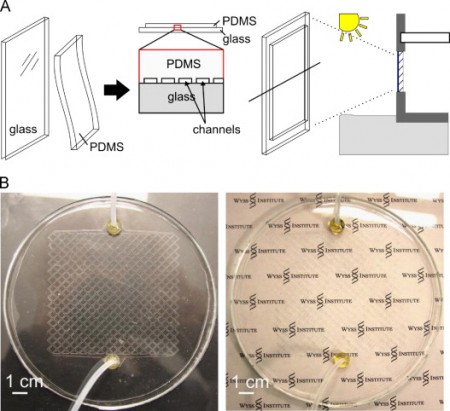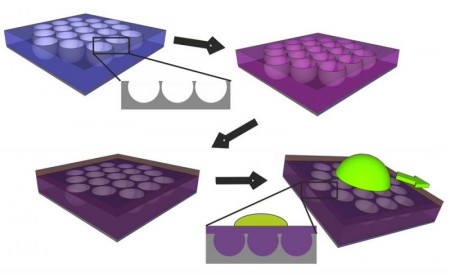Aug
9
Upgrades for Glass Windows Research Report
August 9, 2013 | 2 Comments
Harvard University is involved with two very interesting and quite promising upgrades for glass that can improve windows, solar panels and lots of other uses.
Hatton turned to nature to find a way to make windows more energy efficient. The “bio-inspired approach to thermal control for cooling (or heating) building window surfaces” calls for attaching optically clear, flexible elastomer sheets, bonded to regular glass windowpanes.
The elastomer sheets, made from polydimethylsiloxane (PDMS) have channels running through them through which room temperature water flows. Hatton and his colleagues can claim the technique has resulted in 7 to 9 degrees of cooling in laboratory experiments and is effective both at small and large scales. The results have been published in Solar Energy Materials & Solar Cells.

Vascular System for Windows. A shows a schematic and B the vascular system. Click image for the largest view. Image Credit: Ben Hatton.
Hatton explains, “Our results show that an artificial vascular network within a transparent layer, composed of channels on the micrometer to millimeter scale, and extending over the surface of a window, offers an additional and novel cooling mechanism for building windows and a new thermal control tool for building design.”
Hatton points out that windows account for about 40% of building’s energy costs. “In contrast to man-made thermal control systems, living organisms have evolved an entirely different and highly efficient mechanism to control temperature that is based on the design of internal vascular networks. For example, blood vessels dilate to increase blood flow close to the skin surface to increase convective heat transfer, whereas they constrict and limit flow when our skin is exposed to cold,” he said.
Hatton also notes the technique could also be applied to solar panels, increasing their efficiency. He observes that as the water flows through the panels, it gets hotter, and this hot water could be used to supply heated water to an existing hot water system or to a heat storage system.
Joanna Aizenberg, the Amy Smith Berylson Professor of Materials Science at the Harvard School of Engineering and Applied Sciences (SEAS), a Core Faculty Member at the Wyss Institute for Biologically Inspired Engineering, and Professor of Chemistry and Chemical Biology and principal investigator leads a team that’s invented a new transparent, bioinspired coating making ordinary glass tough, self-cleaning and incredibly slippery.
The result is a resilient, ultraslippery glass that should lead to self-cleaning, scratch-resistant windows, lenses, and solar panels. The research results have been published in Nature Communications.
The new coating builds on an award-winning technology that Aizenberg and her team pioneered called Slippery Liquid-Infused Porous Surfaces (SLIPS) – the slipperiest synthetic surface known. The new coating is equally slippery, but more durable and fully transparent. Together these advances solve longstanding challenges in creating commercially useful materials that repel almost everything.
SLIPS was inspired by the slick strategy of the carnivorous pitcher plant, which lures insects onto the ultraslippery surface of its leaves, where they slide to their doom. Unlike earlier water-repelling materials, SLIPS repels oil and sticky liquids like honey, and it resists ice formation and bacterial biofilms as well. Automotive windshields immediately come to mind for first adopter marketing.
While SLIPS was an important advance, it was also “a proof of principle” – the first step toward a commercially valuable technology, said lead author Nicolas Vogel, a postdoctoral fellow in applied physics at SEAS. “SLIPS repels both oily and aqueous liquids but it’s expensive to make and not transparent,” Vogel said.
The original SLIPS materials also need to be fastened somehow to existing surfaces, which is often not easy.
“It would be easier to take the existing surface and treat it in a certain way to make it slippery,” Vogel explained.
Vogel, Aizenberg, and their colleagues sought to develop a coating that accomplishes this and works as SLIPS does. SLIPS’ thin layer of liquid lubricant allows liquids to flow easily over the surface, much as a thin layer of water in an ice rink helps an ice skater glide.
To create a SLIPS-like coating, the researchers corral a collection of tiny spherical particles of polystyrene, the main ingredient of Styrofoam, on a flat glass surface like a collection of Ping-Pong balls. They pour liquid glass on them until the balls are more than half buried in glass. After the glass solidifies, they burn away the beads, leaving a network of craters that resembles a honeycomb. They then coat that honeycomb with the same liquid lubricant used in SLIPS to create a tough but slippery coating.
“The honeycomb structure is what confers the mechanical stability to the new coating,” said Aizenberg.
By adjusting the width of the honeycomb cells to make them much smaller in diameter than the wavelength of visible light, the researchers kept the coating from reflecting light. This made a glass slide with the coating completely transparent.
These coated glass slides repelled a variety of liquids, just as SLIPS does, including water, octane, wine, olive oil and ketchup. And, like SLIPS, the coating reduced the adhesion of ice to a glass slide by 99 percent. Keeping materials frost-free is important, since adhered ice can take down power lines, decrease the energy efficiency of cooling systems, delay airplanes and lead buildings to collapse.
Of particular concern the honeycomb structure of the SLIPS coating on the glass confers unmatched mechanical robustness. It withstood damage and remained slippery after various treatments that can scratch and compromise ordinary glass surfaces and other popular liquid-repellent materials, including touching, peeling off a piece of tape, and wiping with a tissue.
“We set ourselves a challenging goal: to design a versatile coating that’s as good as SLIPS but much easier to apply, transparent, and much tougher – and that is what we managed,” Aizenberg said.
The team is now honing its method to better coat curved pieces of glass as well as clear plastics such as Plexiglas, and to adapt the method for the rigors of manufacturing.
Looks good, but the jury is still out with windshield wipers, bug strikes, leaves scratching by, heavy rain, abrasive dust and all manner of things in the air scraping by over the years and decades.
Superbly slippery is great. Superbly slippery for decades is much better. It’s immensely creative innovation that might need a bit more coaxing for long life. The manufacturing process for the glass substrate is quite clever. The coating is self-repairing. Lots more performance reviews to come. Lets hope the Harvard team’s work is market ready.
Comments
2 Comments so far



Your post is very nice.I read it carefully.Harvard University is involved with two very interesting and quite promising upgrades for glass that can improve windows, solar panels and lots of other uses.I think it show that what kinds of glass is necessary for our eyes.So a lot of thanks.
I’m very much interested on this glass research. I believe it will be very helpful to get glass security. It’s really very good news that Harvard University involved on this research. My believe it will be so helpful to improve glass.